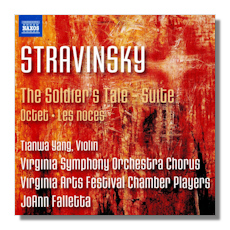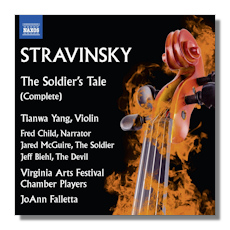
The Internet's Premier Classical Music Source
Related Links
- Stravinsky Reviews
- Latest Reviews
- More Reviews
-
By Composer
-
Collections
DVD & Blu-ray
Books
Concert Reviews
Articles/Interviews
Software
Audio
Search Amazon
Recommended Links
Site News
 CD Review
CD Review
Igor Stravinsky

- Suite "L'Histore du soldat" (The Soldier's Tale) (1920) 26:06 1
- Octet (1923, rev. 1952) 15:07 2
- Les Noces (The Wedding) (1920). 23:26 3
1 Tianwa Yang, violin
3 Rebecca Nash, soprano
3 Robynne Redmon, mezzo-soprano
3 Robert Breault, tenor
3 Denis Sedov, bass
3 Virginia Symphony Chorus
3 Les Noces Percussion Ensemble
1,2 Virginia Arts Festival Chamber Players/JoAnn Falletta
Recorded May 9, 2015 and May 12, 2013
Naxos 8.573538 64:39


The Soldier's Tale (1918, Complete)
- Fred Child, Narrator
- Jared McGuire, The Soldier
- Jeff Biehl, The Devil
Virginia Arts Festival Chamber Players/JoAnn Falletta
Text by Charles Ferdinand Ramuz
English version by Michael Flanders and Kitty Black, revised by Pamela Berlin
Recorded May 9, 2015
Naxos 8.573537 58.02
These works span the period in Stravinsky's composing following Petrouchka (1913), notably the year before the outbreak of the First World War, through that war, up to the early 1920's when Stravinsky's neoclassical period began. The sparse instrumentation of Les Noces reflect the economic realities imposed by the war. For that work Stravinsky eventually settled on four pianos only – and for L'Histoire du soldat he chose clarinet, bassoon, double bass and percussion. The all-wind orchestration of the Octet is a more interesting matter.
Stravinsky wrote an essay explaining his instrumental choice in the Octet. He expressly did not want string instruments here because he had become an extreme formalist and wanted music without any attempt at emotional expression. He was repudiating both romanticism and expressionism and later was notoriously to deny that music was even capable of expressing anything at all. His beautiful Symphony of Psalms was to belie that position by 1930.
What Stravinsky did want in his music, beginning with Sacre du printemps, was emphatic rhythm, and all his works following that display strong rhythms. The earliest of the ones recorded here, Les Noces, displays the kind of rhythms and phrasing taken by Karl Orff in Carmina Burana and other works.A major difference between Orff and Stravinsky is that Stravinsky used more than a single musical line and Orff kept to a single line. The popularity of Orff's best-known work compared to the relative neglect of Stravinsky's Les Noces, undoubtedly has to do with this fact. Another comparison between Stravinsky's work and Orff's is that Carmina Burana is actually part of a trilogy, the final – and least played-- part of which is The Triumph of Aphrodite, a wedding epithalamia, an ancient form.
But let me turn to the first work on this recording, the suite from The Soldier's Tale which Stravinsky extracted in 1920 from his dramatic work, first performed in 1018 in Lausanne, Switzerland. Interestingly, on the invaluable 22-CD Sony set of Stravinsky's works, the Suite is listed as a ballet; the complete work, based on Russian stories, and which can almost be considered a chamber opera, but meant to be read, played and danced, is not included at all. The duration of the Suite is about half the length of the complete work. For those interested in the music rather than the drama, it can be noted that little if any is lost in simply hearing the Suite, because the text as spoken, is not directly accompanied by the music; rather, the two alternate. For those interested in the story, the English translation here is clearly spoken and fully intelligible. I am not going to summarize the rather bizarre plot.
So – the performance of the Suite by Falletta and the Virginia players, as well as the recording, are splendid. Stravinsky would have approved, because the rhythms and phrasing are crisp, angular and vigorous, mostly similar to Stravinsky's own recorded performance. There are two sections of the score where I find Falletta's performance even better than Stravinsky's. The pastoral section of the Suite is more gently pastoral, for one, and in the Tango, later, Falletta brings out the characteristic Tango swoop of the motion better.
The Wedding was written between 1914 and 1917, and was originally scored for a large chamber orchestra, but the final version, in 1923, was for four pianos and percussion. In contrast to the spoken text of The Soldier's Tale, the sung text of this work, particularly when more than one musical line is heard at the same time, is difficult to make out, in fact in my own case it is unintelligible. There is no indication of what language we are hearing, but I presume it is Russian. But the striking rhythms and contrapuntal lines are certainly worth hearing.
Falletta's performance of the Octet, which is in three movements, is very good. Some listeners might give Stravinsky's performance a small edge, but I am not about to split hairs on that.
I give these recordings a high recommendation, especially for The Soldier's Tale Suite.
Copyright © 2016, R. James Tobin


















